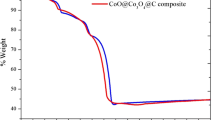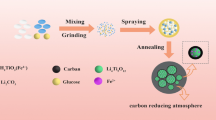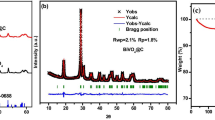Abstract
A skutterudite-related antimonide, CoFe3Sb12, was prepared with vacuum melting. XRD analysis showed the material contained Sb, FeSb2, CoSb2 and CoSb3 phases. The electrochemical properties of the ball-milled CoFe3Sb12−10 wt% graphite composite were studied using pure lithium as the reference electrode. A maximal lithium inserting capacity of about 860 mAh/g was obtained in the first cycle. The reversible capacity of the material was about 560 mAh/g in the first cycle and decreased toca. 320 mAh/g and 250 mAh/g after 10 and 20 cycles respectively.Ex-situ XRD analyses showed that the antimonides in the pristine material were decomposed after the first discharge and that antimony was the active element for lithium to insert into the host material.
Similar content being viewed by others
References
Alcántara, R., Fernándezmadrigal, F.J., Lavela, P., Tirado, J.L., Jumas, J.C., Olivierfourcade, J., 1999. Electrochemical reaction of lithium with the CoSb3 skutterudite.J. Mater. Chem.,9:2517.
Cao, G.S., Zhao, X.B., Li, T., Lü C.P., 2001. Zn4Sb3(−C7) powders as a potential anode materials for lithium-ion batteries.J. Power Source,94:102.
Jiang, X.B., Zhao, X.B., Zhang, X.B., Zhang, L.J., Cao, G.S., Zhou, B.C. 2001. Lithium-ion-storage behaviours of CoSb3 intermetallic compound and effects of some carbonaceous additives.Trans. Nonferrous Met. Soc. China,11:852.
Tritt, T.M., 1999. Thermoelectric materials: holey and unholey semiconductors.Science,283:804.
Wang, J., Raistrick, I.D., Huggins, R.A., 1986. Behavior of some binary lithium alloys as negative electrode in organic solvent-based electrolytes, Electrochemical reaction of lithium with the CoSb3 skutterudite.J. Electrochem. Soc.,133:457.
Zhao, X.B., Cao, G.S., Li, T., 2000. Electrochemical properties of Zn4Sb3 as anode materials for lithium-ion batteries.J. Mater. Sci. Lett.,19:851.
Zhao, X.B., Cao, G.S., 2001. A study of Zn4Sb3 as a negative electrode for secondary lithium cells.Electrochimica Acta,46:891.
Author information
Authors and Affiliations
Corresponding author
Additional information
Project supported by the National Natural Foundation of China (No. 59771032) and the RFDP of the Education Ministry of China (No. 20010335045)
Rights and permissions
About this article
Cite this article
Zhao, Xb., Zhong, Yd. & Cao, Gs. Electrochemical properties of CoFe3Sb12 as potential anode material for lithium-ion batteries. J. Zheijang Univ.-Sci. 5, 418–421 (2004). https://doi.org/10.1631/jzus.2004.0418
Received:
Accepted:
Published:
Issue Date:
DOI: https://doi.org/10.1631/jzus.2004.0418




